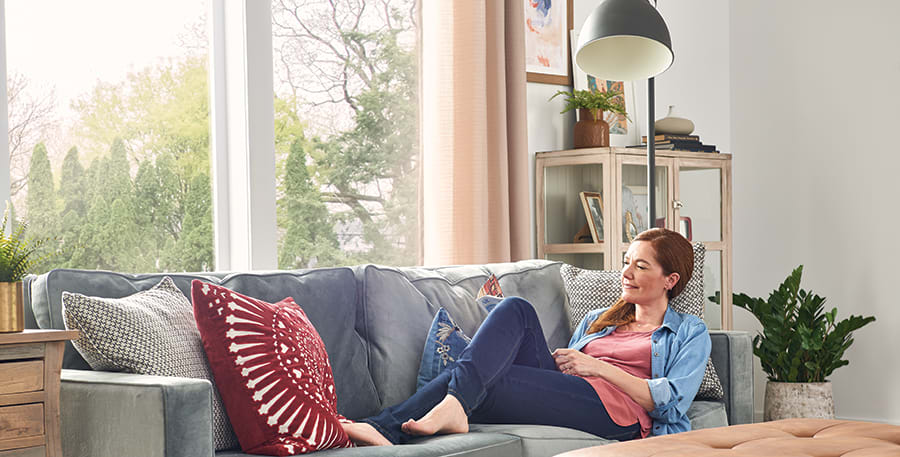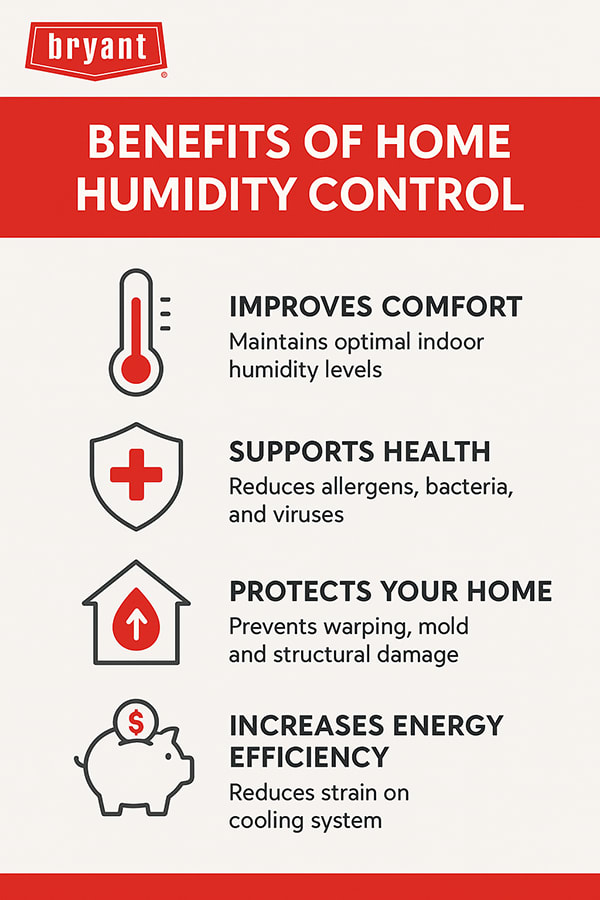About The Author: Travis Baugh is a Digital Brand Marketing Manager for Bryant, where he creates clear, helpful content to guide homeowners through heating, cooling, and indoor air quality decisions. His goal is to empower readers with the knowledge they need to choose the right comfort solutions for their home—confidently and comfortably.
Understanding Humidity Control in Your Home
Humidity control is key to a comfortable, healthy living space. When indoor moisture is balanced, the air feels better, allergens are less likely to thrive, and wood furnishings stay protected—especially during seasonal changes. This guide explains what humidity control means, why it matters, and how to measure and manage it effectively. You’ll also learn how whole-home systems and smart controls work together for ideal comfort. Whether you’re exploring upgrades or a full system, Bryant offers reliable solutions designed to help you achieve consistent indoor conditions with confidence.
What Is Humidity Control?
Humidity control means managing the amount of moisture in your home’s air to maintain a comfortable, healthy environment. It focuses on balancing indoor relative humidity—expressed as a percentage—so conditions never feel overly damp or uncomfortably dry.
Most homes perform best between 30% and 50% relative humidity. Too much moisture encourages mold, dust mites, and musty odors and may cause wood floors or furniture to warp. Air that’s too dry can lead to static electricity, dry skin, and irritation in the eyes, nose, and throat. Balanced humidity helps your home feel warmer in winter and cooler in summer at the same thermostat setting—often reducing energy use when paired with a properly sized HVAC system.
Common strategies include whole-home humidifiers and dehumidifiers that integrate with heating and cooling equipment. Bryant whole-home dehumidifiers reduce excess moisture in warmer months, while Bryant humidifiers add moisture in winter. Smart thermostats can monitor humidity automatically, adjusting for consistent comfort. Combined with regular maintenance and ventilation, these Bryant solutions help manage moisture effectively year-round.
Benefits of Humidity Control
Proper humidity management supports healthier, more comfortable living. Keeping moisture in an optimal range helps reduce dust mites, mold spores, and bacteria that thrive in damp conditions. By moderating humidity, you can improve indoor air quality and enjoy fresher, easier-breathing air throughout your home.
Balanced humidity enhances comfort and wellness. Dry air can irritate skin and sinuses, while overly humid air can feel heavy and sticky. With smart humidity control, your home can feel cooler in summer and warmer in winter at similar temperature settings. Bryant systems use advanced sensors and controls to fine-tune moisture levels, creating a more consistent indoor environment.
Humidity balance also helps protect your home’s finishes and structure. Excess moisture can cause warped wood floors, peeling paint, and window condensation, while overly dry air can crack trim and furniture. Bryant whole-home humidifiers and dehumidifiers help stabilize indoor humidity to protect your furnishings, flooring, and walls—resulting in a more durable home and reduced maintenance.
How to Measure Humidity Levels
Maintaining proper humidity protects comfort, health, and belongings. The most reliable way to monitor indoor moisture is with a digital hygrometer, which provides quick, accurate readings. Place it in key rooms like bedrooms, living areas, and basements—away from direct sunlight or vents. Many Bryant smart thermostats and air quality products include built-in humidity sensors, allowing you to view live readings, set targets, and adjust as needed.
Humidity is expressed as relative humidity (RH)—how much moisture the air holds compared to the maximum it can hold at that temperature. Because warm air holds more moisture, RH changes with temperature. Staying within 30%–50% RH helps prevent static buildup, limit allergen growth, and maintain wood integrity.
Watch for warning signs of humidity imbalance. High humidity can cause condensation on windows, musty odors, and visible mold in bathrooms or basements. Low humidity may lead to dry skin, irritated sinuses, static electricity, and cracking wood. If your readings often fall outside the ideal range, consider a Bryant whole-home humidifier or dehumidifier, which integrates with your HVAC system to balance moisture automatically.

Humidity Control Solutions for Every Home
Balanced humidity is essential for comfort, air quality, and home protection. Bryant offers a full range of humidity control solutions to manage both dry winter air and humid summer conditions.
- Bryant whole-home dehumidifiers work with your central HVAC system to reduce heavy, sticky air and help prevent musty odors or mold growth.
- Bryant whole-home humidifiers add necessary moisture during dry seasons to reduce static, support respiratory comfort, and protect wood furnishings.
Integrating humidity control with your HVAC system delivers consistent, efficient results. Bryant humidifiers and dehumidifiers connect seamlessly with compatible Bryant furnaces, air handlers, and air conditioners, distributing conditioned air through existing ductwork. With proper sizing and placement, your system can respond automatically to seasonal changes, maintaining ideal humidity for comfort and energy savings.
Smart home technology makes managing humidity even easier. Select Bryant smart thermostats can monitor indoor moisture and signal compatible equipment to add or remove humidity as needed. You can check levels, set targets, and manage schedules directly from your smartphone. Whether tackling basement dampness, winter dryness, or year-round balance, Bryant humidity control products provide a smart, integrated approach for lasting comfort.
Tips for Maintaining Ideal Indoor Humidity
Keeping humidity in the recommended 30–50% range helps protect your home and enhance comfort. Seasonal adjustments are key:
- Winter: Indoor air tends to be dry. A Bryant whole-home humidifier can add moisture without over-humidifying.
- Summer: Excess humidity can make rooms feel warmer and promote mold growth. A Bryant dehumidifier or properly sized air conditioner can remove excess moisture while maintaining comfortable temperatures.
Ventilation also plays an important role. Use exhaust fans in kitchens and bathrooms to remove steam, and ensure they vent outdoors. Keep interior doors open when possible, and replace air filters regularly to prevent stagnant air. Homes that benefit from balanced ventilation may consider a Bryant energy recovery ventilator (ERV) or heat recovery ventilator (HRV), which exchange stale indoor air for fresh outdoor air while managing humidity efficiently.
Routine HVAC maintenance supports dependable humidity control. Schedule seasonal service with a Bryant expert to inspect coils, drain lines, thermostats, and sensors. Clean or replace air filters every one to three months for proper airflow. Calibrate smart thermostats and humidity targets as seasons change, and check humidifier or dehumidifier settings to prevent overcorrection.
Connect With A Bryant Dealer On Humidity Control Solutions
With consistent care, your Bryant system can regulate humidity effectively—enhancing comfort, improving indoor air quality, and protecting your home all year long. Schedule an appointment with your local Bryant dealer to identify the solution right for you and get an accurate quote for whole house dehumidifier cost.
Humidity Control FAQs
Humidity control involves maintaining balanced moisture levels in your home’s air. It’s important because it helps protect your home’s structure, improves comfort, and supports healthy indoor air quality by reducing allergens and mold growth.
You can measure indoor humidity with a hygrometer, a small and inexpensive device that displays real-time humidity levels. Many modern thermostats and smart home systems also include built-in humidity sensors.
Excess humidity promotes mold, mildew, and dust mites, which can worsen allergies and respiratory issues. It can also cause musty odors and make your home feel warmer and stuffier.
Whole-home dehumidifiers, proper ventilation, and air conditioning can all help regulate indoor humidity. Using bathroom and kitchen exhaust fans and sealing leaks around windows and doors also helps prevent excess moisture buildup.
Common signs include condensation on windows, musty smells, damp walls or ceilings, and visible mold or mildew. You might also notice sticky air or worsening allergy symptoms.
Learn More
- Discover the best dehumidifier for your home
- Explore whole house dehumidifier options
- Learn what does a dehumidifier do
- Understand dehumidifier benefits
- Discover the benefits of a basement dehumidifier
- Understand when to use a dehumidifier



